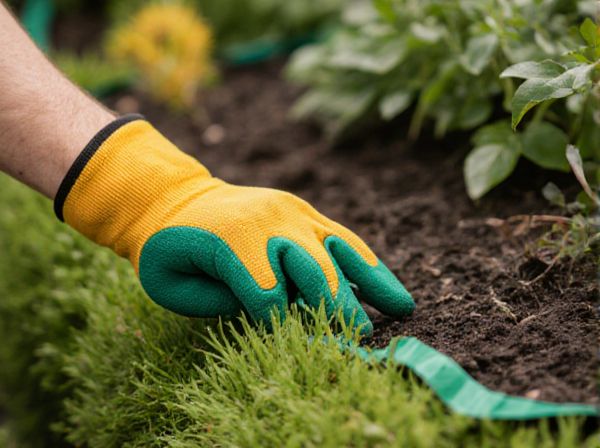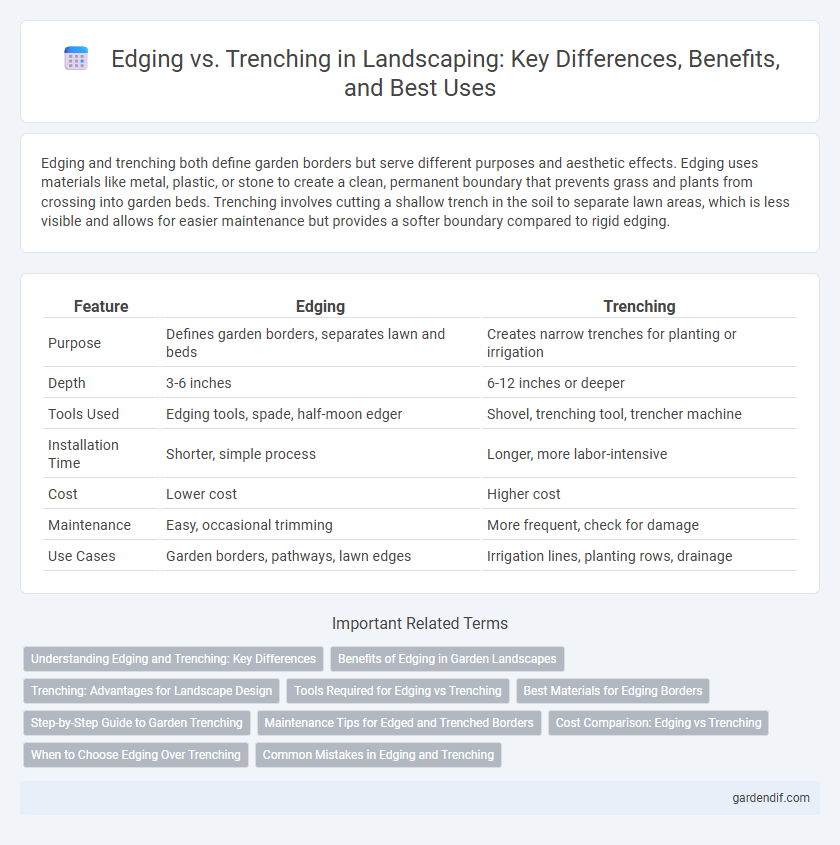
Edging vs Trenching Illustration
Edging and trenching both define garden borders but serve different purposes and aesthetic effects. Edging uses materials like metal, plastic, or stone to create a clean, permanent boundary that prevents grass and plants from crossing into garden beds. Trenching involves cutting a shallow trench in the soil to separate lawn areas, which is less visible and allows for easier maintenance but provides a softer boundary compared to rigid edging.
Table of Comparison
| Feature | Edging | Trenching |
|---|---|---|
| Purpose | Defines garden borders, separates lawn and beds | Creates narrow trenches for planting or irrigation |
| Depth | 3-6 inches | 6-12 inches or deeper |
| Tools Used | Edging tools, spade, half-moon edger | Shovel, trenching tool, trencher machine |
| Installation Time | Shorter, simple process | Longer, more labor-intensive |
| Cost | Lower cost | Higher cost |
| Maintenance | Easy, occasional trimming | More frequent, check for damage |
| Use Cases | Garden borders, pathways, lawn edges | Irrigation lines, planting rows, drainage |
Understanding Edging and Trenching: Key Differences
Edging involves creating a defined border around garden beds or pathways using materials like metal, plastic, or stone to prevent grass and roots from encroaching, enhancing landscape aesthetics and maintenance. Trenching refers to digging narrow, deep channels primarily for installing irrigation systems, drainage, or underground utilities, which improves soil management and plant health. Understanding these key differences ensures proper landscape design, promoting efficient water flow, root control, and clear visual separation.
Benefits of Edging in Garden Landscapes
Edging in garden landscapes enhances curb appeal by creating clean, defined boundaries between lawn and garden beds, reducing grass encroachment and minimizing maintenance efforts. It improves soil retention and helps prevent weed invasion, promoting healthier plant growth and a polished aesthetic. Durable materials like metal, stone, or plastic offer long-lasting solutions that withstand weathering and foot traffic.
Trenching: Advantages for Landscape Design
Trenching offers precise soil separation and enhanced root protection, making it ideal for defining garden beds and pathways in landscape design. This technique improves water drainage and helps prevent erosion, promoting healthier plant growth and maintaining structural integrity. Its ability to create clean lines and control soil movement provides a professional and polished appearance in various landscaping projects.
Tools Required for Edging vs Trenching
Edging requires tools such as manual or powered edgers, spades, and half-moon edgers to create clean, defined borders along pathways and flower beds. Trenching involves more specialized equipment including trenching shovels, trenching machines, and sometimes mini-excavators to dig narrow, deep channels for irrigation or wiring. The choice of tools directly impacts the precision and depth achievable for edging versus trenching tasks in landscaping projects.
Best Materials for Edging Borders
Durable materials like steel, aluminum, and concrete are ideal for edging borders due to their longevity and resistance to soil erosion. Plastic and rubber edging offer flexibility and ease of installation but may degrade faster under harsh weather conditions. Natural stone and brick provide aesthetic appeal and sturdy containment for landscape borders, enhancing both function and appearance.
Step-by-Step Guide to Garden Trenching
Garden trenching involves creating narrow, deep channels in the soil to improve drainage or delineate planting areas. Begin by marking the trench line with string, then use a trenching shovel or spade to dig the trench to a depth of 6 to 12 inches, ensuring straight, clean edges. Compact the soil at the bottom, install any necessary drainage materials, and backfill with topsoil to encourage healthy root growth and soil aeration.
Maintenance Tips for Edged and Trenched Borders
Maintaining edged borders involves regular trimming to prevent grass from encroaching and applying a weed barrier to reduce unwanted growth. Trenched borders require periodic soil replenishment to maintain defined edges and inspection of drainage to avoid water accumulation. Both methods benefit from routine debris removal to preserve clean, sharp lines and promote healthy plant growth.
Cost Comparison: Edging vs Trenching
Edging typically costs less than trenching due to lower labor intensity and simpler installation methods, averaging $1 to $5 per linear foot compared to trenching's $4 to $10 per linear foot. Edging materials like plastic, metal, or stone usually have upfront costs but reduce maintenance expenses, while trenching requires more extensive soil disruption and equipment, increasing both time and expense. Choosing edging over trenching can significantly lower landscaping project budgets while still providing clear boundaries and weed control.
When to Choose Edging Over Trenching
Choose edging over trenching when defining clear, clean boundaries between lawn and garden beds to prevent grass encroachment while enhancing aesthetic appeal. Edging materials such as metal, plastic, or stone provide a durable barrier ideal for frequent mowing and easy maintenance. This method suits landscaped areas requiring precision and minimal soil disturbance, contrasting with trenching's deeper, more labor-intensive approach designed for irrigation or drainage installations.
Common Mistakes in Edging and Trenching
Common mistakes in edging and trenching include improper depth and width, which can lead to unstable borders and poor root protection. Using incorrect tools or cutting too shallow often results in uneven lines and soil erosion, compromising the landscape's integrity. Neglecting to compact the soil after trenching causes shifting and settling, affecting plant health and overall design durability.
Edging vs Trenching Infographic

 gardendif.com
gardendif.com